HISTORY OF THE HOOVER FIRE DEPARTMENT
In 1952 the Alabama Highway Department began a six mile project from the crest of Shades Mountain south to the Cahaba River. This project was to build a four-lane highway that would run through what we know today as the city of Hoover.
Prior to this period the area was a small farming community with lakes and rolling hills, but the construction of the highway would bring tremendous growth to the area in the form of housing, commercial and retail establishments, hotels and many other forms of businesses that make up a community.
Mr. William Hoover, Sr. began to purchase land in the area around 1954, primarily around Green Valley Shopping Center and Greenvale Road. Mr. Hoover liked to build and see things built and his dream was to build a city.
In 1958 Mr. Hoover moved his highly successful insurance company from downtown Birmingham to Hoover on Highway 31 expressing his confidence that the growth of Birmingham would move south placing the new office building in a prime area. Soon, residential areas began developing around Star Lake, Deo Dara, Helen Circle, Whispering Pines, Spruce Drive as well as the development of Green Valley Country Club. In December 1961, Green Valley Drugs opened in what is known today as Green Valley Shopping Center. The drug store has served as a local landmark for several years.
As the area grew, local residents had a desire for improving fire protection. A series of brush fires that threatened many of the newly constructed homes required several men from Employers Insurance to rush to the aid of the residents and help control the fires. Fire protection at the time came from the Rocky Ridge Fire Protection District.
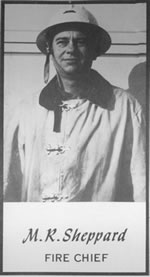
The first order of business for the newly formed fire department was to appoint a Fire Chief. This honor went to Mr. Ralph Sheppard. Once the Chief was appointed, the department was ready to purchase a pumper. Chief Sheppard contacted Chief John Swindall, Birmingham Fire Department and presented the needs of the department and was able to purchase its first pumper, a 1944 Mack. The pumper is operable today and has been refurbished and is used for parades and other public relations affairs.
The first year of operation proved successful and much interest was generated throughout the community. Hoover did not have a fire station so the engine was housed in the carport of the President of the Fire District, Mr. Del Hyche, who lived on Star Lake Drive. Fire drills were held several times each week and usually conducted around Star Lake or behind Employers Insurance. Often times, Vestavia Fire Department would drill with Hoover Fire Department.
Several months after the fire department formed, Mr. Hoover was asked to provide some land for a shelter to be built that would house the fire engine and fire gear. He offered the use of the land behind Employers Insurance. Soon, the volunteers constructed a small tin building that abutted the Employers Insurance Building. This became the first Hoover Fire Station.
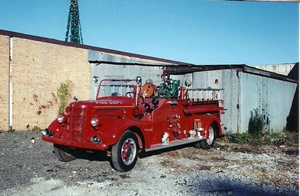
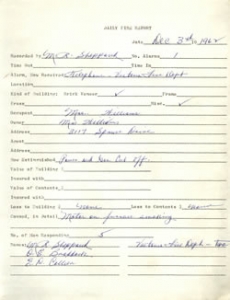
When an individual wanted to report a fire he or she would call the fire department number which would reach an answering service. The answering service operator would get all of the information and would in turn dial an unlisted phone number that would activate a siren on top of Employers Insurance. The first volunteer to arrive would turn the siren off, get the information from the answering service, write the address on the blackboard and the first three men to arrive would proceed to the fire. There was never a problem of having at least three men arrive on the first alarm and often times, ten to fifteen would respond. The first recorded fire call came on December 3, 1962, to 3117 Spruce Drive. The cause in detail was listed as a “motor on furnace smoking.” In all, the department responded to three fire calls in its first year of operation.
The entire area continued to prosper and the fire department took on more responsibility. In 1963 the Hoover Volunteer Fire Department took in the Patton Chapel area. Although there were fire hydrants located in the Green Valley area, there were few or no fire hydrants located in the Patton Chapel area. Chief Sheppard as well as several other volunteers saw a need for another pumper that would increase the water capacity of the department by 500 to 600 gallons.
Again, Birmingham Fire Department proved to be the source for another pumper. During a quarterly meeting of the Hoover Volunteer Fire Department, the members voted to purchase a 1938 500-gpm pumper for $600.00 dollars. It was pointed out by one of the members that any expenditures over five hundred dollars must be approved by the entire membership. However, there was a need to act expeditiously and the board took the responsibility of purchasing the pumper. The purchase of the pumper took place in
January, 1964. Also, in this same meeting, the members voted to allocate funds to increase the size of the tin building to two bays. Volunteers began construction immediately and completed the building that now housed two Hoover pumpers. The cost to the citizens for the construction was two hundred dollars.
In December of 1964 petitions were circulated to call for a vote for incorporation of the area as the town of Hoover. However, the measure failed when put to a vote 119 to 87. By the end of 1964 there were several new businesses and homes in the area as more people began to move to the new suburb. The Fire Department was answering calls in the Green Valley area, Patton Chapel and along Highway 31. However, the first structure fire the department responded to was on February 14, 1963 to Box 95, Route 13, in Cahaba River Estates located off of Highway 150. In 1962 there were three fire calls, 1963 there were thirteen fire calls, and by the end of 1964, there were eighteen fire calls.
A called meeting of the Hoover Fire Department Board of Directors on April 14, 1965 would be to discuss what would be the first big capital project of the department. The meeting was attended by President John Hodnett, Cecil Woods, Ray Dunbar, O.E. Braddock, Ed Ernst, Mr. Sharfer, Mr. Tipton, and Chief Ralph Sheppard. President Hodnett called for a discussion of building a Hoover Fire Hall. John Hodnett and Cecil Woods were appointed to contact Mr. Hoover about purchasing a piece of land to erect a fire station. A piece of property behind Employers Insurance seemed to be the ideal location. After meeting with Mr. Hoover, Mr. Hoover decided to lease the land for one dollar a year to the Hoover Volunteer Fire Department.
The Board of Directors met again on July 27, 1965 to discuss the matter and the lease was accepted from Mr. Hoover. Mr. Fred Buck offered to construct the station at his cost. The cost of the station was projected to be $5500.00 to $6000.00. The Treasurer, O.E. Braddock estimated current funds to be around $2000.00 dollars and expected to receive an additional $6500.00 for 1965-66 Fire Dues. After further discussion the issue to build a station was voted on with all members voting yes. The station consisted of two bays, a kitchen area and sleeping area. Although the original structure has been altered several times, most of the original building stands today and houses Engine Company One.
The volunteers were quite busy that year fighting several house fires and fires in commercial establishments. On the morning of May 31, 1965, Hoover Volunteer Fire Department along with Vestavia Hills Fire Department and Homewood Fire Department would respond to the worst possible call firefighter faces- a structure fire with a child trapped. Firefighters were called to 3052 Lorna Road, Valley Trailer Park. Upon arrival they were faced with a trailer well involved with fire with a child trapped inside. Several people tried to enter the burning structure to rescue the child, but to no avail. After the fire was out, the gruesome task of searching for the child was left to the firefighters. Just as it had been reported, the firefighters discovered the body of four year old Gerald Maurice Belcher. Homewood Fire Marshal Howard Fields would investigate the scene as well as the Jefferson County Sheriffs Department and the State Fire Marshals office. Several fires would be fought at the Valley Trailer Park over the years until progress pushed the park out and made way for Bruno’s Food store.
The area continued to grow and the volunteer department continued to serve the newly formed “Town of Hoover” well. For many years the Fire Station behind Employers Insurance served as the City Hall and Police Station. Often prisoners were held in the bathroom of the station until the Sheriff arrived because the young city did not have a jail. The size of the volunteer staff grew and included many individuals who would go on to become civic leaders such as, Mayor O. E. Braddock, Mayor John Hodnett, Mayor Frank Skinner, Councilman Howard Rasco, Councilman Ralph Sheppard, and Councilman Bill Cartwright. The other men who served as early as 1966 included: Milton Tipton, Darrel Holmes, Frank Skinner, Sr., Papa Ed Ernst, Mike Thigpen, Ray Dunbar, Cecil Woods, Raymond Patton, and Charlie Ball.
In 1968, the department wanted to improve the ISO fire rating. Chief Sheppard was told he would need full time coverage to improve the rating. An arrangement was made to house Samford University students at the station who would live there, respond to calls and take care of the station while not attending classes. Most importantly, the department would purchase its first new fire engine pumper truck- a 1967-750 GPM International Pumper purchased for $8000.00. By doing this and buying additional equipment such as fire hose, nozzles and other vital equipment, the department in 1968 was able to improve the ISO Rating to Class 6.
In 1970, the department purchased it second new pumper-1970 Ford 1000 GPM pumper. In 1972 and 1973 several full time firefighters were hired. In addition to responding to fire calls, the department was now responding to all first aid calls in the area. By 1973, the department covered much of Chapel Hill, Patton Chapel, Foothills, Green Valley, and Highway 31 from Columbiana Road to the Cahaba River Bridge. It was obvious by 1972 that the area would continue to have rapid growth and it was evident by the number of homes being built in the area.
During the early 70’s, from 1972 to 1980, one of the most popular television shows was Emergency. The program is thought to be responsible for the present day model of Fire based EMS delivery. In 1973, the cities of Birmingham, Homewood, Vestavia and Hoover were the first cities in Alabama to provide paramedic coverage for their citizens. Hoover shared the cost of manning and purchasing a rescue unit that was housed and staffed by Vestavia Hills Fire Department. When a medical call was received within the city of Hoover, Hoover firefighters would respond and Vestavia Hills would respond the Hoover –Vestavia Rescue Unit R-30. During that year, Hoover Fire Department purchased its first rescue unit, a 1974 van. All of the modifications needed to convert this van to a rescue unit were performed and completed by Hoover Fire Department personnel. Several civic clubs, including the Hoover Service Club became involved purchasing advanced life support equipment for the fire department. Through their efforts, this club purchased sophisticated telemetry equipment that was used by paramedics to talk with the hospital physician. As the demand for EMS grew, it became evident that Hoover Fire Department would need to man there on rescue unit and late 1974 hired the first full time paramedics.
By 1976, the city had established its second fire station at 1581 Patton Chapel Road. The department had grown to fifteen full time employees. Additionally, the city purchased the first ladder truck for the department. This 1976 Ford Diesel 65’ ladder truck is still used today as a reserve ladder.

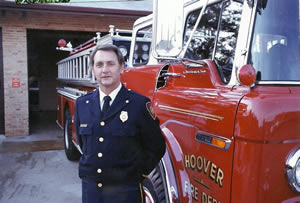
The city continued to operate with a full time staff and volunteer support. It became apparent that the city was going to grow, the department was going to grow and the need for full time leadership had arrived. Up until 1976, the Hoover Volunteer Fire Department was supported by dues and subsidized by the city of Hoover. However, in 1976 the city took over the full time operation of the department and its employees and hired the first full time Fire Chief, Tom Bradley. Chief Bradley had retired as a Captain with the Birmingham Fire Department. For the next 33 years, Chief Bradley developed a small paid/volunteer department into one of the most respected professional departments in the Southeast.
By 1978, the department had grown to 24 full time employees, including fifteen trained fire-paramedics. Hoover Fire Department although small, was recognized as a professional department offering the citizens excellent fire and emergency medical service. In 1979, the position of Fire Marshal was established.
The 1980’s were probably the most pivotal time in the city’s history. Although pockets of land around Patton Chapel, Al Seier, Chapel Hill, Rocky Ridge, Loch Ridge, were being annexed into the city, the annexation of the Riverchase Fire District obviously had the greatest impact. That annexation started the tremendous growth in the city and in turn fueled the growth of the department. Riverchase was a planned residential upscale community that included the Data Center, and later Blue Cross Blue Shield as well as plans for the largest shopping mall in the South. The district was annexed and their employees taken into the Hoover Fire Department. The fire station was located just north of the old Cahaba River Bridge on Lower Lorna Road in a building converted into a fire station. The city was unable to maintain that location and moved the station across the street in a vacant doctor’s office. In addition to the men hired from Riverchase, eight additional men were hired to man the station. Eventually, in December 1981, Fire Station Three, located at 803 Riverchase Parkway West was built and manned by these firefighters.


The Riverchase annexation proved to be extremely beneficial and the city enjoyed tremendous residential and commercial growth throughout the 80’s. In 1985, the Riverchase Galleria project started and presented different types of problems to the young department in the form of high rise buildings. It would not take long in the construction life of this project to test Hoover Fire Department. On the morning of June 6, 1985 shortly after shift change, the department received a fire call to the 17-story office tower. All three stations responded and long before arriving on the scene, it was apparent the biggest fire in Hoover Fire Department history was burning on the top three floors of this complex. Two factors played an important role in controlling this fire. First, although the building standpipes were not in service, the department had required one temporary dry standpipe be installed. Secondly, the fire occurring at shift change nearly doubled the departments on strength size and that proved to be invaluable as the operation to extinguish this fire played out. This was the first fire Hoover Fire Department ever faced higher than three floors. The first arriving engine supplied the standpipe and the first of several crews rode a construction elevator to reach the fire floor. For some unknown reason the elevator carrying the first crew stopped on the 9th floor. Not to be defeated, this crew climbed eight more floors on makeshift construction ladders to reach the fire. Many lessons were learned that day. The way the department responded and handled the fire was best summed up in the editorial page of the Birmingham News stating that the department faced the challenge and did an outstanding job. This fire and the way the department handled it enabled Hoover Fire Department to grow up and helped develop confidence in many young officers and firefighters.
By 1985, the city was spread out and rumors of more annexations filled the department. The three engine companies, one truck company and one rescue unit covered and area roughly defined by I 65 and Highway 31 on the north end of the city, to Highway 119 at Valley Station at the south end of the city, sparse areas of Bluff Park off of Chapel Road and much of Shades Crest Road to Highway 150 as the western end of the city and Rocky Ridge Road at Big Paul circle as the eastern border of the city. Each Station was commanded by a Station Captain who on his shift, acted as the shift commander. However, since the captain was part of an engine crew and if an incident occurred somewhere outside of his territory, he was unable to actually be on site to command the incident. In 1985, Chief Bradley replaced the station captains with lieutenants and the captains were placed in a car and began responding throughout the city as a true shift commander.
The area around the Riverchase Galleria and Riverchase continued to develop with commercial buildings, multi family apartments and single-family homes. The on duty strength of the department was increased by adding a fourth engine company at Fire Station 3 in September 1985 until the completion of Fire Station 4. Shortly after, in December 1985 the Bluff Park Fire District was annexed which added a fifth Engine Company and second rescue unit. The Bluff Park Fire District was well established and experienced in firefighting and emergency medical service. When Bluff Park Fire District was annexed, it was the oldest fire district in the State of Alabama. All District employees were brought into Hoover Fire Department carrying with them their full seniority. Most members were paramedics as well. This brought the total strength of the department by years end to five engine companies, one truck company, two rescue units, one shift commander, the Fire Marshal and the Fire Chief for a total of seventy six personnel. The annexation of Bluff Park moved Hoover into the position of the second largest city in Jefferson County.
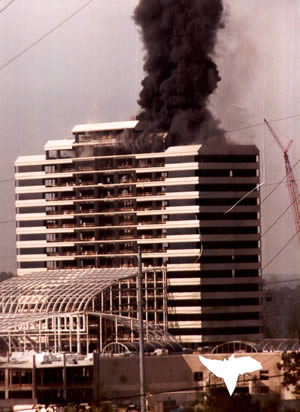
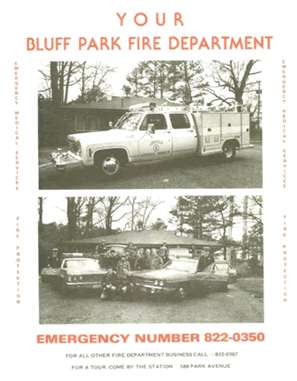
The growth of the 80’s continued especially on the western end of town around Shades Crest and Highway 150. Residential development along South Shades Crest Road, Highway 150, Sulphur Springs, and Shades Crest Road dictated another station be placed in service to cover that area and future annexations in that territory. In 1988, two fire stations were opened. Fire Station Six was opened in July 1988 to cover the western end of town adding eleven personnel, and Fire Station 4 was opened in December on Old Rocky Ridge Road (now Municipal Drive). Engine Company 4 had operated out of Station 3 so the opening of this station saw that engine company move to Fire Station 4.
Although most of Riverchase was in Shelby County, Hoover did not extend very far eastward into Shelby County. In 1990 that changed when the city annexed two large areas along the Highway 280 corridor. In May of 1990 the city annexed all of the commercial area of Inverness including two large shopping centers on Highway 280 and several mid-rise office buildings along Inverness Parkway. As part of the annexation agreement, the city agreed to place an engine company and rescue unit in service to cover that area. Once the annexation took affect, the city was committed to providing this coverage and immediately located land to place a temporary station in service. Temporary Fire Station 7 was located off of Inverness Parkway close to Lake Heather. An old trailer was placed on the site and a shed to house the equipment was built by Hoover Firefighters. Within one week, Engine Company 7 and Rescue 42 were placed in service at this temporary site. These two companies operated out of that station until 1994 when Fire Station 7 was completed at the end of Inverness Parkway and Valleydale Road.
The city of Hoover has always placed the highest importance on Public Safety. The ability to have fire apparatus on the scene quickly as well as Advanced Life Support on the scene quickly always received highest priority. Also, the city, as early as 1976 made every effort to provide an excellent ISO rating for the citizens and businesses of Hoover. In 1976 the department held an ISO 6 rating. By 1978 it had improved to a Class 5, by 1981 improved to Class 4, by 1983 improved to Class 3, by 1989 improved to Class 2. The department was resurveyed in 1999 and remained Class 2. To help maintain this rating, the department placed an additional ladder company in service at Fire Station 7.
Today the department operates out of nine fire stations and covers about fifty square miles. The annual budget exceeds eighteen million dollars. There are 171 employees, including a full time training officer, EMS Officer, Fire Marshal and Three Fire Prevention Officers. All engine companies and truck companies are staffed with at least two paramedic and provide full ALS service. All rescue units are transport capable insuring a rapid transport to the hospital for patients who are critically injured or sick. The department operates a Hazardous Material Unit, Technical Rescue Team for response to high angle, confined space and swift water rescues.
In 2009, after thirty three years of service, Chief Tom Bradley retired. Chief John C. Wingate was named Chief and continues in that position today.
Written by: Battalion Chief Frank V. Brocato,
Date: December 23, 1999 Edited: July 5, 2011
Acknowledgment: Fire Chief Tom Bradley | Fire Chief Ralph Sheppard


